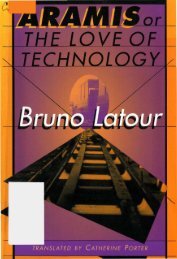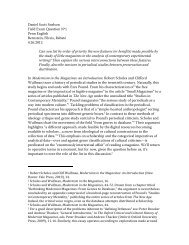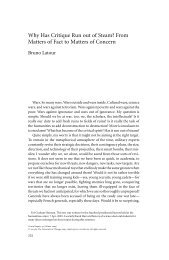The Exploit: A Theory of Networks - asounder
The Exploit: A Theory of Networks - asounder
The Exploit: A Theory of Networks - asounder
You also want an ePaper? Increase the reach of your titles
YUMPU automatically turns print PDFs into web optimized ePapers that Google loves.
140 Edges<br />
Perhaps in the ontological inversion <strong>of</strong> graph theory and networks a<br />
new kind <strong>of</strong> “politics <strong>of</strong> desertion” will be discovered.<br />
Pure Metal<br />
A theme <strong>of</strong>ten repeated in poststructuralist thought is the so - called<br />
decentering <strong>of</strong> the liberal - humanist subject, a trend that led to charges<br />
<strong>of</strong> antihumanism against such thinkers. <strong>The</strong>re is no presocial, universal,<br />
or essential self, one is told; there is only the play <strong>of</strong> surface<br />
effects and signs, themselves largely determined by social, economic,<br />
and political forces. <strong>The</strong> question is not “who am I?” but rather “how<br />
did an ‘I’ become so central to our social, economic, and political existence?”<br />
This cultural constructionism therefore focuses less on an<br />
innate self or identity than on the ways that gender/ sexuality, race/<br />
ethnicity, and class/ status form, shape, and construct a self.<br />
In this debate over the decentering or the recentering <strong>of</strong> the human<br />
subject, we wonder: what <strong>of</strong> the nonhuman, that which seemingly does<br />
not concern us at all? <strong>The</strong> term “nonhuman” has in fact been used in<br />
science studies and media studies, for example, by Bruno Latour. Focusing<br />
on knowledge production in the sciences, Latour notes that any<br />
scientific experiment involves not only human investigators but a range<br />
<strong>of</strong> “nonhuman actants” (rather than human actors) that may include<br />
laboratory technologies, organisms, materials, research grants, institutions<br />
and corporations, and so on. Latour gives a simpler, if more mundane,<br />
example: the speed bump. Speed bumps do nothing on their<br />
own; they simply exist as inert matter. Yet their presence affects our<br />
human actions (slowing down, swerving). Human made, yes, but their<br />
being crafted by humans (or, more appropriately, machines) says<br />
nothing about their interactions with human beings and their integration<br />
into the everydayness <strong>of</strong> the human world. This integration<br />
leads Latour to speak <strong>of</strong> a “parliament <strong>of</strong> things,” a “nonmodern Constitution”<br />
in which even “things” seem to be democratic. Yet despite<br />
Latour’s emphasis on the way that human actions are influenced by<br />
nonhuman actants, there is a sense in which the nonhuman is still<br />
anthropomorphized, a sense in which the circumference <strong>of</strong> the human<br />
is simply expanded.









